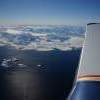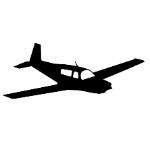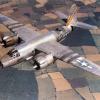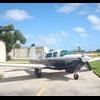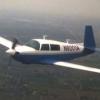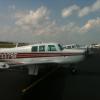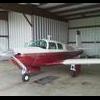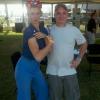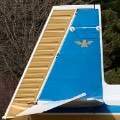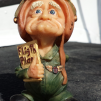Leaderboard
Popular Content
Showing content with the highest reputation on 07/18/2016 in all areas
-
Since top overhaul cylinder #4 was 30F-50F hotter than the other five jugs. In summer, it was hard to keep the #4 CHT below 400F in cruise. I went through many recommended diagnosis and fix steps: Cleaned fuel nozzles, cleaned and swapped plugs, checked JPI data for weak ignition, for induction leak and GAMI spread (.2 gal) - all no finding nor any impact. During another detailed inspection of the baffles (looked fine) I checked the oil cooler installation: It was sealed at the bottom with high temp RTV but it had a a big hidden gap at the upper part between oil cooler and firewall. Closed this gap with high temp RTV and ... #4 temperature dropped to normal level! Conclusion: Search for the obvious first! :-)7 points
-
So the answer is, the Cessna pilot should have: -Had the Cessna engine removed and then had a Mooney engine installed. and then -Had the Cessna airframe removed and had a Mooney airframe installed.4 points
-
Yeah, why listen to the folks who actually know what they're talking about when there are guys like Peter and Byron around to pontificate? Hey Bennett, Aaron, Philip, youse guys getting paid by PFS to shill for them? I don't need to shill for anybody. I freely admit I buy all sorts of "go fasts" for my Mooney, and I'm a bit of an avionics junky, but I don't think anyone else should follow my crazy pathway. I do so for my own pleasure. Fortunately I can just about afford to indulge myself. I am not taking away anything from from kids, nor my grown up grandkids. Flying, sailing, classic cars are all passions. I still work full time, owning a couple of businesses, and how I spend the money I earn is my own business.4 points
-
I figure I should close the loop on this for the benefit of anyone who might have a similar problem. The alternator was returned to the shop that overhauled it, they suspected a faulty diode but found none. However upon returning everything to service the cackling has stopped. Not one pop. Upon reinstallation my mechanic added a shielded ground wire to the field circuit. So either the act of removing and then reinstalling the alternator tightened up a previously loose connection or the shielded ground wire did the trick. FYI3 points
-
Just got off the phone with Roger Tucker, the chief mechanic at OSU. Either he or his mechanic will come down and fix the airplane. The fat lady hasn't yet sung, but it looks like Oshkosh is back on.3 points
-
If their in house guy cant weld like this find someone who can, Chassis Builders (drag racing) work with thin wall 4130 everyday, TIG (heli-arc) is the only way to have it done. What city/state are you in?3 points
-
And the answer is: "just another average flight in a Mooney"2 points
-
2 points
-
I needed to fly customers from the U.P. to Mankato, MN on Thursday and my Rocket was AOG for a leaking waste gate controller (internally leaking out the drain line). Customers wouldn't wait for my plane to be repaired (would drive over and buy from the dealer instead of my dealership on a transfer). Since the weather was generally good, and Steve offered up his "E" model (N1258X) which was a real need of some flying time, I decided to fly the customers over in the "E". Steve and I went up the day before to check the plane over (just out of annual and MANY calendar days since last flight). It was at that time I realized he has no autopilot. Not a deal stopper, but it's been over 15 years since I flown a plane without that "back-up" option. I found out really quick how much my hand flying skills had eroded from too much dependence on the autopilot. I DO fly without it, but generally turn it on even on those flights when dealing with "in cockpit issues". Within 20 minutes I was getting comfortable with it, but was amazed how quickly the plane would start rolling when I looked down for more than a couple seconds for radio and navigation adjustments, or other distractions. When I was just south of Minneapolis I was given a "descend and maintain 4,000'" from 6k and I started down. His E model has a bunch of speed mods, so descent management is more challenging than my Rocket (higher red line, 3 blade prop and speed brakes) without hitting the NE red line. After just 40-50 seconds I get another "repeat" of the original descent instruction (and I am down 500' already). I read back again and then a Supervisor comes on and asks me to expedite my descent. With throttle just above gear horn blaring, I get it down at 800' a minute with the airspeed just below red line. My next instruction after leveling at 4k is descend to 2800'. When I reply back, I add I had the plane just below red line to get his earlier request "to expedite descent". Later, with the airport in site and cancelling IFR, the Supervisor comes on and specifically thanks me for the help. .................Got to wonder, was he working a new controller? They sure didn't give me the descent instruction early enough to get what they wanted without extra work on my side (surely they didn't think I was a turbo prop with my "E model speed" flying into the wind). On the trip back I got some quality IMC time, which could have been avoided with either a 2k climb or descent, but I clearly needed the practice. I felt a lot better about my hand flying skills at the fourth hour than I did in the first 30 minutes. George is going to turned off a lot more frequently after that wake up call. My first 1300 hours of IFR was all done sans autopilot, with lots of hard IMC, but having that option since those days has sure made me lazy. Tom2 points
-
And when your other half kick you out of the house you have a place (hangar) to go and spend time with your lovely Mooney and sleep over together. Happy dreams. José2 points
-
2 points
-
A bunch of old guys that got tired of talking about Mooney mufflers and now they are into pilot's mufflers. José2 points
-
This is my viewpoint as well. That's 1,146 gallons of 100LL for my prices. Divided by 10 gallons an hour, that's over 100 hours of flight time at lets lay 135kts versus 0 hours at 140kts. Unless my exhaust needed replacing I doubt I would make the jump.2 points
-
Today's trip. I wish I could say it was from my plane. But seat 11A wasn't too bad. Sent from my iPad using Tapatalk2 points
-
Here's an option on replacing the Lifesaver battery: http://www.csobeech.com/files/MidContinentBattery-9015607.pdf1 point
-
I too have the MC Lifesaver with the battery backup. Yes, the battery is expensive, and I replace it at every other annual, but the presentation is clear and familiar. I have the "inclinometer" option for the "ball". All in all I am very pleased with unit. With all my other backups I see no reason to replace it with an EFIS variant (at least not now). Fly long enough and you will have some instrument or avionics failures - vacuum or electric. Redundancy can save your life, and in my opinion, a panel mounted unit that becomes part of your regular scan is easiest to transition to in an emergency.1 point
-
I checked, but I didn't see my questions: 1. What on earth does my Anus need checking for in order to fly? There have been a ton of Third Class Medicals performed... somehow they got by without checking the Anus. But now, thanks to the AOPA... 2. What on earth did Mark Baker do to earn $780K in 2014? Is saying publicly that he is advocating for Pilots and then "negotiating" laws that require Private Pilots to get their Anus checked really worth all that? Couldn't even half that money been better spent furthering aviation? Or hey... I know, this is just crazy talk... reducing our annual "membership" fee? https://www.aopa.org/-/media/files/aopa/home/about-aopa/governance/aopa-governance-page/2014foundationform990.pdf?la=en (Scroll down to Page 11) I'm really just trying to make the FAQ page more useful.1 point
-
You're getting close. I'm still pretty sure she's a girl though in spite of somebody spray-painting "DICK" across her sides.[emoji846] Sometimes graffiti artists have no heart. If she wasn't a girl I'd lean heavily towards Calvin. But then in keeping with inside jokes I could retain the "theme" and name her "Rickie" (as in Rickie Lee Jones). As a youth I endured much teasing during the popular run of "Chuck E.'s In Love" and to this day still love the song! I may run it by the wife for an opinion. Thanks for your help; where do I send the check? Chuck Sent from my iPad using Tapatalk1 point
-
Bruce, you might want to buy a ticket for the Mooney Caravan BBQ on Tuesday night in the North 40. I am sure that there will be a lot of MooneySpacers there as well. I attend every year even though I hadn't flown the Caravan. This year I am thrilled because I am! Also, make sure to stop by the Mooney International Pavilion, The Ambassadors/Mooney Girls there all week. And MAPA is close by too.1 point
-
You said in another old thread you burn more fuel with the power flow. Yes or no? Cooler temps with higher fuel burn and a little more speed. No thank you.1 point
-
I would take it to autzone and try to find one that's visually similar. Start with the alternator for a 1972 ford. anothet thing, open it up and try to find a number off the rectifier. Some may also have press fit diodes too, you can rob the ford alternator for the diodes, or the whole rectifier.1 point
-
1 point
-
Why you flying spam can on a nice day light that? Tom Simple reason, my Mooney would run out of fuel before I made it to the UK. [emoji15][emoji50] Sent from my iPad using Tapatalk1 point
-
Oh I forgot one thing turn off Otto and had fly everything while you are preparing to get your instrument rating.1 point
-
The one thing threads like this do is they remind me just how much I love my 201! Keep it going! IMO the M20J is the epitome of the perfect airplane. Refined and perfected in Kerville. It does not need any "speed mods" precisely because its so perfect the way it is! No pf exhaust no lopresti cowl, nothing! So instead of spending thousands upon thousands for a dubious knot here or there, I put a small fraction of those $s into proper maintenance keeping my J in tip top shape and of course for 100LL to enjoy it as much as I can. Did I mention I absolutely love my Mooney?1 point
-
Make sure the holes in the tubing are caused by corrosion and not just holes drilled for PK screws that hold or might have held metal brackets for mounting ur plastic.1 point
-
Raptor - Yes, I've done that analysis. PTK - No, there is. And as I wrote, and my analysis showed, my CHTs are higher, not lower, consistent with more combustion (and more power). I don't know why someone would experience lower temps, I did not. Bob, you didn't ask me, but no I'm not being paid. And if I wasn't happy after being promised gains, I certainly wouldn't make up something to convince myself, much less others. But I'll beg off this thread ... You can see performance for yourself when I see you at MSN next week. Sent from my iPhone using Tapatalk1 point
-
Here is the new Instrument ACS, the flying portion and the regs haven't changed. I used Sporty's for both my PPL and IR, get comfortable flying under the hood, straight & level, climbs & descents on a heading and while turning to a heading. Power settings are a big part as well so get use to your Mooney, then grap an instructor and have some white knuckle, sweaty palm fun1 point
-
Co-pilot jacks blew my ear drums out. Thought I'd already tried this, so I get the bone head award. Ill start with the jack. Thanks folks! Sent from my iPhone using Tapatalk1 point
-
I have had two Mooneys because I want to fly fast. Both have had many speed mods to that purpose. I've had 4 Cessnas, (120, 150, 2 -172s), an LSA DOVA, and a two Pipers, and none of them provided the satisfaction of cruising at Mooney speeds. Sure my Mooneys burn (burned) more fuel, but economy is not my first priority. I can run LOP, and I will sacrifice speed for certain long distance flights to avoid a fuel stop, but generally I set up the aircraft for speed. I understand why some pilots prefer to operate at lower fuel burns, but living in Northern California with $750/month hangar fees, $1,500 annual Personal Property taxes, and our outrageous labor and sales tax for parts for aircraft maintenance, fuel prices are a lesser percentage of overall costs as compared to other parts of the country.1 point
-
TStepp, sorry about that. It's a 1967 M20F. I have small-kid-induced brain mush. Website corrected. Thanks for catching that.1 point
-
I was going into Baltimore many years ago in the Rocket for a dealer meeting, up in the flight level with a decent tailwind (260 knots GS) and I started asking the controller several times for lower, to which he denied. Finally he gives me a crossing restriction for 12k at an intersection for which I was not familiar (don't fly out east very often). I set the descent up at 1k a minute while I looked for the crossing point. Just as I find it and realize there is no way I can make it, even with everything hanging out, the controller comes on and asks me if I can make the crossing restriction (the same one that had denied me my earlier descent requests). A little perturbed, I replied "No, not with both wings still on the plane". He comes back with "360 approved". He must have thought I was a turboprop. Tom1 point
-
I did mine 4 years ago independently with an independent instructor. Technically all the information needed is available from the FAA web site. I purchases several IFR book as well. I have posted before 1. start by looking at approach plates and learning the symbols on them and understanding what they are telling you 2. talk to instrument rated pilots 4. go up by in the plane on a good VFR day at an uncontrolled airport and fly the approaches while looking out the window to get the feel of where you are and what the instruments are telling you 5. find a safety pilot and get some hood time just flying point a to b and maneuvering the plane independent of approaches. 6. start using low altitude en-route charts for VFR flights and learn the symbols on them 7. Study the AIM on instrument procedures 8. find an instructor and get hood time form him as well as let him file IFR plan and get some real IMC time much different form hood time. 9. get one of the practice exam programs and take the written exam multiple times.1 point
-
The kma24 is pretty common. If you have a buddy with the same panel, you might try swapping them just to isolate the problem.1 point
-
I don't know Tom....although I'm not an "new" Mooney guy those exact thoughts were going through my head.....1 point
-
Your Kidney probably is worthless from all the single malt you have run through it !!!!1 point
-
My guess on the delays is aligned with N601RX. They blocked out an annual inspection with you and you gave them a project. I think it is fair to sit down with ownership and map out a timeline. I also think you should have a conversation with the mechanic who maintained it for the past 5 years. You took it to a MSC to obviously see what your current mechanic was missing. Now you know. I would look to see if SB-208 was ever completed on the plane. Your previous mechanic should have verified that was completed. It is more than just inspecting the tubing, it also deals with insulation that promoted the corrosion. Sent from my iPad using Tapatalk1 point
-
1 point
-
A standard exhaust leaves behind as much as 20% of spent gases. So they say. The premise of tuned exhaust is to evacuate these gases thus making room for the new ones. I get that. But they go on to say that the tuned exhaust allows as much as 95% intake of pure fuel air. So we're talking, at best, about a 15% delta between the standard exhaust and a 4K $ tuned one! Considering also that there is no free lunch, what kind of gains do folks think they're going to get with this? (At yesterday's prices where I filled up 4K $ would buy 941 gal of 100LL!)1 point
-
The pax seat back in my '68 C was badly cracked in 5 or 6 places. Stop drilled all cracks where needed and riveted 0.020 2024 patches over each crack. Seat back is solid now. Sent from my iPhone using Tapatalk1 point
-
My POH (from 1975) doesn't give that info. That would be great, though. Since the OP has a J, he will have it, other IO360 models probably pretty close, FYI:1 point
-
Thanks, I have taken this whole process very seriously. Some things you just need to experience before you fully comprehend the gravity of a statement. Landing in 24knt crosswinds with wind 18g30 on a runway thats 75ft wide will change your thought process on a lot of things. Like me, this gentleman doesn't know what he is getting into yet because he hasnt started down the path. Right now he is just getting information about the path; So some people in here I think can be a little harsh seeing that his mind can change between now and PPL. I started out wanting a twin which today i think is even more crazy than a rocket. So let him do his research, let him start lessons, and let him learn what it is to be a pilot. Chances are he too will come to a conclusion that there is more involved than just raw speed. There is a long road ahead, so nothing is written in stone.1 point
-
I've had aircraft tied down in the open, under T-Shades, and mostly in hangars. I am bit of a hangar fanatic by most standards, but I find tremendous value in utilizing hangars. I set up a mini-office in my last two hangars, with a computer, printer, refrigerator, water cooler, coffee maker, desks, workbenches, drill press, tool storage,etc. plus cabinets to hold all the "stuff" I use for airplanes. I also added many shelves to hold storage boxes, catalogued, and cross catalogued for find the oddball things I know I have "somewhere". I could never manage this from a tie down. Here in the San Francisco Bay Area, hangar costs are ridiculously high, and the waiting lists are long. Even so, I cannot imagine leaving my Mooneys outside in the weather. Cessna 172s and Pipers, OK when I didn't have a hangar available, but even my Cessna 120 was hangared. If you are ever around KSQL come and visit . When I leave the hangar doors open, and work at my desk there are always pilots and friends stopping by to chat.1 point
-
I wanted the interior in my Ovation to be nicer to look at and more comfortable to sit on. Fellow Mooneyspace pilot and 231 owner Rico Flyin Bullfrog crafted new leather seats in two shades of grey on new foam for all four seats. He replaced the carpets on the floor and lower side panels, recovered the armrests and improved the seat pockets. He even created a special pouch for the GRC 10 control on the copilot side. The interior is a great upgrade and I recommend his work highly.1 point
-
You haven't read anything? So you are passing off your assumption as fact? The TCDS for the IO-390 (E00006NY) clearly states the HP rating is 210 at 2700 RPM for takeoff AND max continuous. It also states minimum fuel as 100LL (I was wrong). Cylinders are $3600 each vs. $2200 each. Slick mags are the only ones listed on th TCDS, your experience with their reliability is your own. I have both Slicks and CMI magd go 500 hours regularly without failure. If I was getting a factory engine, it would be the IO-390. I just overhaulled my IO-360-A1A for less than $15k, so obviously, that is a whole different ballgame.1 point
-
The ability to store tools, oil, covers and accessories when not being used is very nice, too. I bought some Gorilla shelving to out stuff on, it filled up rapidly. My folded canopy cover in its stuff bag takes up half of the top shelf. Two cases of oil are in the bottom shelf. I have a set of plastic shelving for liquids (Wash-n-Wax, Tri Flo, etc). Then there's the roll around tool box for oil changes, annual, etc. its the less-discussed benefit of hangaring.1 point
-
1 point
-
After going through the logbooks and seeing the plane, I felt the asking price was fair. Josh and I are both happy with the deal and in my opinion that's the way deals should be made. The wife liked the color, and she is happy. Also very important.1 point
-
1 point
-
To get back to the original thread topic of engine reliability between the O-360 and IO-360, both engines are very reliable, and of course each engine is its own unique individual. My experience is that the Lycoming O-360 carbureted engine is one of the most bullet proof engines around, and generally forgiving if it is abused (within limits, of course). Perhaps this is due to slightly lower power output (45 HP per cylinder vs. 50). The IO-360 is a bit more temperamental and maintenance intensive, and the cylinders are only available from Lycoming, no aftermarket cylinders exist. -It is hard to beat the reliability and simplicity of a carbureted engine- less maintenance and never a hot start issue. -It is hard to beat the efficiency of the fuel injected engine, especially Lean of Peak. -The M20E is quickest, but the M20C is close and generally a lot cheaper to acquire and maintain. As to carburetor icing- the carb on a Lycoming is bolted directly to the hot oil pan. Carburetor ice is possible, of course, but not nearly as likely as on a Continental, where the carb is out in mid-air. Fear of carburetor ice should not factor into the equation.1 point

